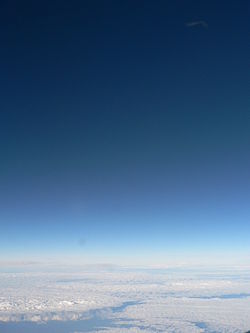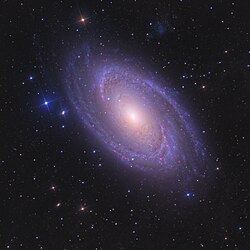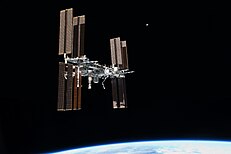Rymden
Rymden, även yttre rymden eller världsrymden, är de relativt tomma områdena i universum som finns utanför himlakropparnas atmosfärer. Begreppet används ibland med den alternativa betydelsen universum.
Det finns ingen klar gräns mellan jordens atmosfär och rymden eftersom atmosfärens densitet minskar gradvis ju längre man kommer från jorden. Emellertid har Fédération Aéronautique Internationale tagit fram den så kallade Karmanlinjen, som ligger på en altitud av 100 kilometer över havsytan, som en arbetsdefinition för att skilja mellan rymd- och luftfart. Denna definition används eftersom på altituder över cirka 100 kilometer, beräknade Theodore von Kármán, måste en farkost färdas snabbare än jordens omloppshastighet för att kunna få tillräcklig lyftkraft från atmosfären. I USA har man bestämt att personer som färdas på en altitud över 80 kilometer betraktas som astronauter. Vid återinträde i atmosfären brukar 120 kilometer vara den gräns då man börjar märka av luftmotståndet, detta beror dock mycket på farkostens ballistiska koefficient.
I motsats till vad många tror är rymden inte helt tom (det vill säga inte ett perfekt vakuum), utan innehåller nästan överallt en tunn gas, huvudsakligen i plasmatillstånd, såväl som elektromagnetisk strålning. Förhållandena i rymdplasmat benämnes ofta rymdväder. Hypotetiskt (eller troligen) innehåller rymden även stora mängder mörk materia och mörk energi.
Rymdens början

Jordens atmosfär blir gradvis tunnare utan någon tydlig gräns, så hållpunkterna mellan jorden och rymden är något godtyckliga. Dessutom utgår mätningar ifrån havsytan, som inte är helt sfärisk, eftersom jorden är tillplattad vid polerna. Det innebär att jordens högsta berg är Mount Everest, med 8 848 meter över havet, medan det är Chimborazo, ett berg nära ekvatorn, som har sin topp längst från jordens kärna.[1]
- 8 000 m ö h: Dödszonen – människor som vistas över denna höjd riskerar att dö av syrebrist.[2] (Kan ske redan över 2 500 m höjd p.g.a. höjdsjuka)
- 8 848 m ö h: Mount Everest, jordytans högsta punkt.
- 10–18 km: Tropopausen – troposfären övergår gradvis i stratosfären kring denna höjd.
- 37,6 km: Höjdrekord för flygplan utan raketmotor eller liknande[3]
- 80,5 km (50 miles): NASA:s gräns för rymden.
- 100 km: Karmanlinjen, rymdens gräns enligt Fédération Aéronautique Internationale.
- 110 km: Norrskenets undre gräns
- 160 km: Undre gräns för en något så när stabil omloppsbana runt jorden.[4]
- 360 km: Medelhöjd för Internationella rymdstationen
- 35 786 km: Geostationära banan. Här finns väder- och kommunikationssatelliter.
- 320 000 km: Den närmaste av Lagrangepunkterna, (L1), i jorden-månen-systemet, där jordens och månens gravitation tar ut varandra.
Basartiklar
Himlakroppar
Källor
- ^ US Department of Commerce, National Oceanic and Atmospheric Administration. ”What is the highest point on Earth as measured from Earth's center?” (på amerikansk engelska). oceanservice.noaa.gov. https://oceanservice.noaa.gov/facts/highestpoint.html. Läst 30 december 2022.
- ^ ”Everest:The Death Zone”. Nova. PBS. 24 februari 1998. http://www.pbs.org/wgbh/nova/transcripts/2506everest.html.
- ^ Powered Aeroplanes Arkiverad 10 maj 2016 hämtat från the Wayback Machine. (sök på C-absolute och Altitude)
- ^ ”IADC Space Debris Mitigation Guidelines” (PDF). Inter-Agency Space Debris Coordination Committee. 15 oktober 2002. Arkiverad från originalet den 3 december 2013. https://web.archive.org/web/20131203014608/http://www.iadc-online.org/Documents/IADC-2002-01,%20IADC%20Space%20Debris%20Guidelines,%20Revision%201.pdf. Läst 25 maj 2014.
Media som används på denna webbplats
- Short description: Astronaut Buzz Aldrin on the moon
- Full description: Astronaut Buzz Aldrin, lunar module pilot, walks on the surface of the Moon near the leg of the Lunar Module (LM) "Eagle" during the Apollo 11 extravehicular activity (EVA). Astronaut Neil A. Armstrong, commander, took this photograph with a 70mm lunar surface camera. While astronauts Armstrong and Aldrin descended in the Lunar Module (LM) "Eagle" to explore the Sea of Tranquility region of the Moon, astronaut Michael Collins, command module pilot, remained with the Command and Service Modules (CSM) "Columbia" in lunar orbit.
- Variations: The upper black band is an addition to the original photo, carried out for "reasons of balance". See the original photo and the explanation of the edit at NASA's website. In the expanded version of the photo, it is possible to see a horizontal white line at the top left (viewer's right) of the helmet. This is the base of the antenna that was cut in the original frame of the photo.
STS-135 final flyaround of ISS
This picture of the International Space Station was photographed from the space shuttle Atlantis as the orbiting complex and the shuttle performed their relative separation in the early hours of July 19, 2011. Onboard the station were Russian cosmonauts Andrey Borisenko, Expedition 28 commander; Sergei Volkov and Alexander Samokutyaev, both flight engineers; Japan Aerospace Exploration astronaut Satoshi Furukawa, and NASA astronauts Mike Fossum and Ron Garan, all flight engineers. Onboard the shuttle were NASA astronauts Chris Ferguson, STS-135 commander; Doug Hurley, pilot; and Sandy Magnus and Rex Walheim, both mission specialists.
Space seen from airplane
Författare/Upphovsman: Benh LIEU SONG (Flickr), Licens: CC BY-SA 4.0
Gazing at the milky way at the Pannecière lake, in the Morvan National Park, France. Taken at the very end of August 2019, when Saturn was in opposition and hence very bright (next to my right hand). Although generally speaking, Morvan, maybe the darkest place in France, has little light pollution, this picture shows a lot of it because of the small village of Château-Chinon and because of the very long exposition.
Författare/Upphovsman: Ken Crawford, Licens: CC BY-SA 4.0
M81 also known as Bode's Galaxy is around 12 million light years away. It has an irregular satellite galaxy known as Holmberg IX.








